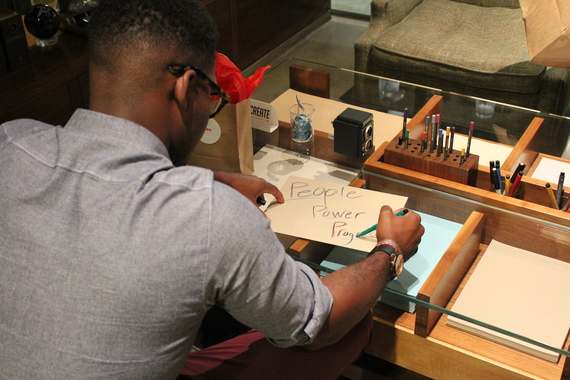Recently, I joined hundreds of arts advocates at Los Angeles City Hall as a guest speaker for ArtsDay, part of an annual celebration of Arts Week 2016 focused on continuing and expanding investment in the arts. This collaborative effort is led by Arts for LA and Councilman Mitch O'Farrell with support from both the City and County of Los Angeles. The arts matter immensely, but some may not realize just how important the arts and arts education are as a key strategy to disrupt and dismantle the school-to-prison pipeline.
The school-to-prison pipeline is essentially a set of policies and practices that favor incarceration over education, punishment over rehabilitation, reinforce zero-tolerance policies, and disproportionately push students - particularly students of color and an overwhelming number of boys - out of the classroom and into our juvenile halls and camps. The data is striking:
- 70% of students arrested or referred to police at school are Black or Latino.
- 50% of school-based arrests are for "disturbance of the peace" or "disruptive conduct."
- 75% of youth are incarcerated on charges that pose little to no threat to public safety, such as probation violations, status offenses (e.g. running away, skipping school), and property, public order, and drug offenses.
Ultimately, all roads lead to jail, prison, or even worse - unless there is some intervention.
The school-to-prison pipeline - which too often starts when student behavior is addressed in a manner that is disproportionate to the offending act - is symptomatic in many instances of unaddressed trauma and the need for healing. We know exposure to traumatic events in childhood and adolescence plays a significant role in perpetuating cycles of abuse and poverty. And a significant amount of research shows that traumatic experiences alter brain development. Chronic stress and exposure to traumatic events places children and youth in constant fight, flight, or freeze mode. Within this context it is easy to understand the interconnectedness between trauma that goes unaddressed and the pipeline that goes from school-to-prison.
The arts create an off-ramp from the pipeline by engaging young people and empowering them. Art is not a distraction - but a diversionary tool for them to heal and tell their stories through spoken word, dance, poetry, performance art or a visual piece. Art provides freedom from the everyday struggles that our children and youth must navigate. It channels creativity and gives young people the power to be kids again by allowing them to reclaim their childhood. Art increases self-esteem and an understanding of culture and one's history.
I grew up going to Barnsdall Art Park in the East Hollywood region of Los Angeles, watching my younger sister dance at Lula Washington's Dance Theater on Adams Boulevard, and being exposed to the paintings of Walt Walker. Early birthdays were spent being enthralled by the ingenuity on display at the Bob Baker Marionette Theater. My parents kept us busy with trips to museums and countless summer hours making pottery and paintings that always hung on the walls of our home. Later in life the rhythmic and pulsating sounds of Alvin Ailey's "Revelations" kept me on the edge of my seat and I began a love affair with the jazz music that played every time I rode in a car with my mom and dad.
The arts have played a fundamental role in my life. That's why I was so proud to join the governing board for the Arts for Incarcerated Youth Network (AIYN) led by my dear friend Kaile Schilling. AIYN is an organization comprised of eight incredible arts providers who serve incarcerated youth within Los Angeles County. The idea is that through the arts we can build resiliency and wellness, eliminate recidivism and transform the juvenile justice system. But most of all, AIYN is helping to unlock and heal the deep trauma that so many of our youth hold within.
Other organizations such as RYSE Youth Center in Richmond and Destiny Arts in Oakland have created safe spaces for young people and are brilliant examples of local programs healing children and youth through trauma-informed mental health treatment paired with exposure to the arts.
I'm a firm believer in the transformative power of the arts to save lives and as part of a smart workforce-development and reentry strategy for incarcerated youth, particularly in Los Angeles County where arts related industries are one of the largest and the fastest growing sectors.
Investing in the arts and arts education however must begin well before a young person enters into incarceration. It must begin with early childhood education as it is one of the core building blocks of child development. Every child, regardless of zip code, should be exposed to the arts in order to receive a well-rounded education. As a board member of the Los Angeles County Board of Education, I am excited that the Los Angeles County High School for the Arts (LACHSA) is one of the premier public arts high schools in the nation.
The arts can take shape in many ways and many forms - but the bottom line is that for young people we know it will improve their achievement in school and is a critical strategy to dismantle the school-to-prison pipeline while addressing trauma. Giving children and youth strategies to express their pain, and cope with the stress, prepares them for a strong future. As we learn more about the brain and the effects of trauma on youth, our system, policies, programs and allocation of resources must change to reflect this new knowledge. Healing the effects of trauma builds hope and resiliency; and, resilient children grow up to live healthy productive lives.
The arts matter more than we might realize as we seek to positively impact young people. We can and we must do more.


